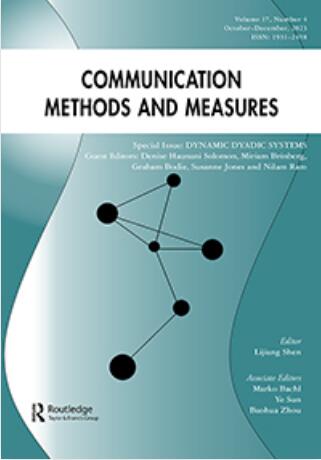Uncovering Hidden Media Framings in Generic Communication Competence Assessments: Is the Face-To-Face Context the Default Framing?
IF 3.7
1区 文学
Q1 COMMUNICATION
引用次数: 1
Abstract
Dispositional communication competencies can be assessed in (a) a generic form that does not include any reference to a particular medium of interaction or in (b) a communication medium-specific version. To date, little is known about the specific media that individuals use as a reference and the weights they assign to them when responding to generic communication items - an important research gap because the use of diverse communication media has risen considerably during the COVID-19 pandemic. Based on media theories, two hypotheses were derived: Generic ratings contain a "hidden" face-to-face (FtF) communication framing that is dominant in the cognitive processing (media naturalness perspective) versus media are equally weighted in the mental aggregate of respondents (adaptation perspective). According to a preregistered study plan, generic and medium-specific communication items were assessed to investigate these hypotheses (referencing FtF, videoconferencing, chat, and e-mail interaction contexts). Training (n = 200) and test (n = 389) datasets were analyzed using latent variable modeling. Results indicated that generic ratings have a strong hidden FtF framing. These hidden framings impact the predictive power of the competencies to explain communication criteria (i.e. communication satisfaction). Exploratory analyses indicated that individual differences in media experience may affect the framings.揭示通用沟通能力评估中隐藏的媒体框架:面对面情境是默认框架吗?
性格沟通能力的评估可以采用(a)不包括任何特定互动媒介的通用形式,或(b)特定于沟通媒介的版本。迄今为止,人们对个人用作参考的具体媒体以及他们在回应通用传播项目时赋予这些媒体的权重知之甚少——这是一个重要的研究空白,因为在2019冠状病毒病大流行期间,多种传播媒体的使用大幅增加。基于媒体理论,我们得出了两个假设:一般评级包含在认知加工中占主导地位的“隐藏”面对面(FtF)沟通框架(媒体自然性视角),而媒体在受访者的心理总量中占同等权重(适应视角)。根据预先登记的研究计划,评估一般和特定媒介的交流项目以调查这些假设(参考FtF,视频会议,聊天和电子邮件交互环境)。训练(n = 200)和检验(n = 389)数据集采用潜在变量建模进行分析。结果表明,通用评级具有很强的隐藏FtF帧。这些隐藏的框架影响了解释沟通标准(即沟通满意度)的能力的预测能力。探索性分析表明,媒介体验的个体差异可能会影响框架。
本文章由计算机程序翻译,如有差异,请以英文原文为准。
求助全文
约1分钟内获得全文
求助全文
来源期刊

Communication Methods and Measures
COMMUNICATION-
CiteScore
21.10
自引率
1.80%
发文量
9
期刊介绍:
Communication Methods and Measures aims to achieve several goals in the field of communication research. Firstly, it aims to bring attention to and showcase developments in both qualitative and quantitative research methodologies to communication scholars. This journal serves as a platform for researchers across the field to discuss and disseminate methodological tools and approaches.
Additionally, Communication Methods and Measures seeks to improve research design and analysis practices by offering suggestions for improvement. It aims to introduce new methods of measurement that are valuable to communication scientists or enhance existing methods. The journal encourages submissions that focus on methods for enhancing research design and theory testing, employing both quantitative and qualitative approaches.
Furthermore, the journal is open to articles devoted to exploring the epistemological aspects relevant to communication research methodologies. It welcomes well-written manuscripts that demonstrate the use of methods and articles that highlight the advantages of lesser-known or newer methods over those traditionally used in communication.
In summary, Communication Methods and Measures strives to advance the field of communication research by showcasing and discussing innovative methodologies, improving research practices, and introducing new measurement methods.
 求助内容:
求助内容: 应助结果提醒方式:
应助结果提醒方式:


